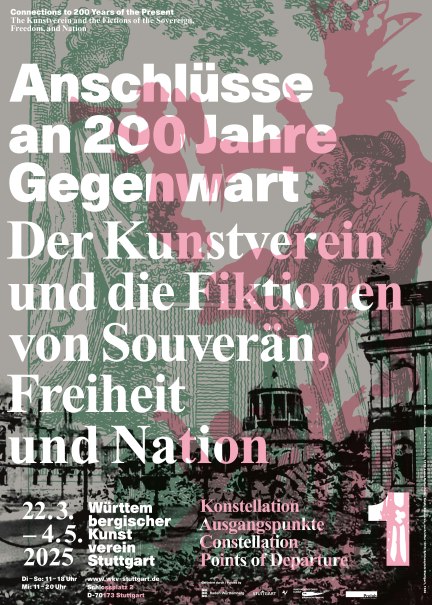Anschlüsse an 200 Jahre Gegenwart. Der Kunstverein und die Fiktionen von Souverän, Freiheit und Nation
- Location:
- Kunstgebäude Stuttgart, Schloßplatz 2, 70173 Stuttgart
- Date
Please check the individual dates in the calendar overview.
With works and editions by:
Daniel García Andújar, Ricardo Basbaum, Daniel Chodowiecki, Stan Douglas, Luise Duttenhofer, Till Gathmann, HAP Grieshaber, Christoph Irrgang, Vika Kirchenbauer, Ferdinand Kriwet, Muntadas, Suntag NOH, Anna Oppermann, Dan Perjovschi and many more
2027 marks the 200th anniversary of the founding of the Württembergischer Kunstverein (WKV). On the way there, the WKV will pursue three central ideas that are closely interwoven with the founding of art associations at the beginning of the 19th century from today's perspective in a two-year open process: the constitution of the (white, male) citizen as sovereign; the freedom of art and nation-building. The local particularities and concrete developments of the WKV are reflected upon in terms of their global interconnections. Linear concepts of time are to be deliberately disrupted.
A series of exhibitions is planned that will reflect on possible connections between the past, present and future in four constellations. All four constellations are open arrangements between exhibition, archive and workshop. They are essentially characterized by searching, viewing, questioning, gaps, the unexpected, the provisional and new questions.
The starting point of the first constellation is an initial selection of clusters of people, themes and questions with which the WKV opens its research journey. Founding members such as the merchant, bank director and self-proclaimed art dilettante Gottlob Heinrich Rapp, the publisher Johann Friedrich Cotta (also known as the "Bonaparte of the book trade") and the lawyer August Friedrich Köstlin (Ulrike Meinhof's great-great-great-uncle) are examined. They stand for the newly emerging type of self-confident educated and propertied citizen who rises socially by trading, holding political office and engaging in art and culture: A type that the artist Luise Duttenhofer comments on ironically in her silhouettes.
At this time, artists were emancipating themselves from courtly patrons, whereby the new freedom of art was immediately accompanied by its restriction through censorship and its dependence on new groups of buyers. The function of the first art associations was to mediate between art, artists and an art public and art market that was only just emerging at the time. A lottery system is central to this: members acquire shares, which are used to buy works by "patriotic" artists and distribute them by lot among the members.
Another focus of this first constellation concerns the question of the entanglements and continuities between colonialism, nationalism/national socialism and modernism - and how these are also reflected in the positions and protagonists of the WKV.
In addition to this critical look at the history of the WKV, the exhibition also highlights the recurring moments and attitudes. For in their long history, art associations have been able to establish themselves, much more so than municipal or state institutions, primarily as free spaces for art: a role and responsibility that must be constantly re-explored and renegotiated.

